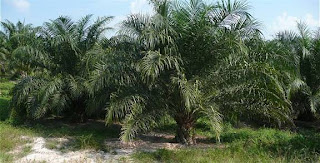Although essentially an estate crop,
oil palm has been successfully adapted to suit the needs of smallholders and has proved a powerful tool for poverty alleviation in
Indonesia, positively affecting millions. Significant improvement in living standards, including income, education and health levels are attributed to the economic development benefits of oil palm cultivation. Total growing area is distributed among three groups, which include government holdings, private companies and small holders. According to Indonesia
Bureau of Statistics (
BPS) in 2006, 45 percent of total palm area is owned by private companies, followed closely at 43 percent by small holders, and the government comprising the remaining 12 percent. Small holders are frequently part of partnership scheme with private companies. Total area for Indonesia palm oil in 2006 is estimated at 6.07 million hectares according to a information from the Indonesia
Palm Oil Board (
IPOB).
Photograph showing six year old plantation palms just begining productive years

Prospects For The Future
The government of Indonesia’s development of
palm oil production through land concessions to large companies, government plantations, and small holder programs has been clearly successful in securing edible oil and generating foreign exchange. The subsequent rise in
palm oil production has also resulted in the loss of tropical rain forests and generated major concerns about the effect of
palm oil production on habitat loss for many endangered species and the reduction of biodiversity. Most recently, the Indonesian government, working with some
palm oil producing companies is negotiating sustainability standards with Europe and the United States under the auspices of
Roundtable on Sustainable Palm Oil (
RSPO). RSPO is an international organization of producers, distributors, conservationists and other stakeholders.
During plantation visits on Sumatra and Borneo, Cargill and Musim Mas; the agricultural assessment team was shown many of the sustainable practices and positive reinvestments made back into the work force and the surrounding community. The team was shown projects such as schools, nurseries, clinics, and produce markets. The demand for palm oil will likely remain strong and research and development work is being done in both top producing countries of Indonesia and Malaysia. Yields will steadily increase as the newly planted areas enter into their twenty year plus productive lifecycle. In addition, replanting will continue to adopt better suited varieties developed from hybrid research and cloning.
The availability of land in Indonesia, coupled with recent years of high seed sales, record energy prices, and high vegetable oil prices are factors that will result in Indonesia continuing to lead the world in
palm oil production for years to come.
A plantation’s long term success depends in part on well timed replanting operations. This requires a steady supply of high quality seed, seedlings, and young palms from breeders and nursery operations who specialize in this part of the industry. The availability of quality hybrid seeds is essential for establishing plantations and replanting. Only the highest quality seeds are selected for use.
Seeds are hand inspected for quality characteristics prior to being released for sale or use. A germinated seed is cultured in the pre-nursery for 3 months, then moved to a nursery to develop for an additional 9 to 10 months. After this initial phase from germination to plant establishment of one year, the plants are culled for the best characteristics and then planted in the field. After 30 to 36 months in the field the young palms begin to produce the first harvestable fruit bunches. The first bunches are small and weigh only 2 to 3 kg and the individual fruitlets comprising the bunch are small in size.
Peak harvest (or palm productivity) occurs from years 8 to 15. The economically viable life span of an oil palm is typically 22 to 25 years depending upon oil price, economically harvestable height, and yield. Oil palms can exceed 70 to 100 feet in height, however they are typically removed from production when they reach 25 feet, which coincides with an average age of 25 years. The 25 feet height is an industry limit which is based loosely on the height of the average harvester plus the length of the long sickle harvesting pole.

Artikel keren lainnya:
Belum ada tanggapan untuk "Distribution of Palm Oil Area and by Holdings"
Post a Comment
Kritik dan Saran yang membangun dari Anda sangat KAMI harapkan.
Silahkan isi KOMENTAR anda yang membangun untuk kemajuan dan koreksi di blog ini.No Sara, No Racism